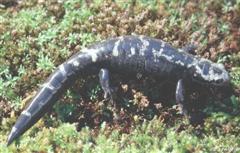Salamander - Marbled
Scientific Name: Ambystoma opacum
Thu, 10th July, 2025 - 1:30 am GMT
Sponsor Ads:

Alternative Name
Scientific Name: Ambystoma opacumBasic Info
The Marbled Salamander grows to be 4 to 5 inches at maturity. Their body is black and white with a marbled pattern. Some specimens are entirely black or white, but this is rare. Marbled Salamanders have short and stocky bodies with stubby tails. They have 11 or 12 costal grooves. Males have a more silvery color and swollen cloacal glands.
Health
Marbled Salamanders are relatively undemanding. They should be kept at a temperature around 75 degrees, but never above 85 degrees. Humidity should be light. Marbled Salamanders can be fed worms, small insects, and prepared foods such as turtle pellets. All pellets should be soaked in water prior to feeding. A body of water deep enough for the Marbled Salamander to soak in is required. The water should always be kept clean. Breeding Unlike other salamanders, the Marbled Salamander breeds in the fall, and they breed on land. When a male and female meet, the male will attempt to court the female by moving in circles. The male will then deposit a spermatophore on the ground. The female will then pick up the deposit with her cloaca. At this point, the female will go off on her own and will lay her eggs in a depression in the ground. At typical clutch will consist of 50 to 100 eggs. The eggs will hatch during the next rain, when their depression becomes flooded. If rain does not come, the eggs have a chance of lasting through the winter and hatching in the spring. The larvae of the Marbled Salamander are gray in color. Maturity is reached in eight to nine months. Larvae eat other salamander eggs, small insects, snails, and other small invertebrates.Habitat
Marbled Salamanders are mostly found near small bodies of water, such as streams and ponds.Behavior
The Marbled Salamander is an interesting creature. They are sought after by many hobbyists for their wonderful coloration and their general undemanding nature and ease of care. The Marbled Salamander is a reclusive salamander. They spend most of their time in their self made underground burrows. They are nocturnal animals, and they do their hunting at night. Marbled Salamanders are quite fun to watch. Handling should be kept to a minimum. A Marbled Salamander habitat should have a deep soil and leaf substrate for burrowing. A pool of water and plenty of vegetation and hiding spots are also necessary. Their tank should be sealed to prevent escape.Origin
North AmericaHistory
The Marbled Salamander, or Ambystoma opacum, is found throughout Midwestern America, from Florida to New England. They are a considered to be a threatened species in Michigan.Common Foods
feeds primarily on insects, earthworms, small rodents, small animals.Sponsor Ads:
- it's the grain of sand in your shoe.
Salamander - Marbled
Coded by: BGID® | ALL RIGHTS RESERVED Copyright © 2000-2025
Disclaimer | Privacy | Report Errors / Contact | Credits
















